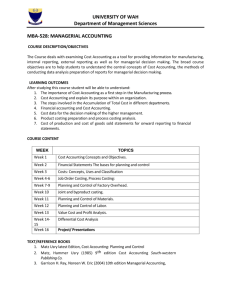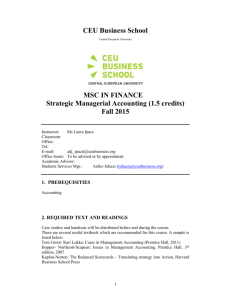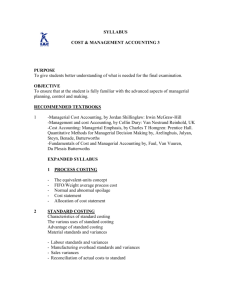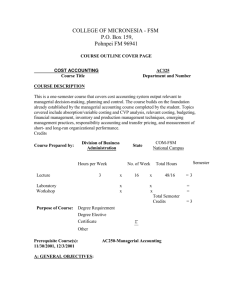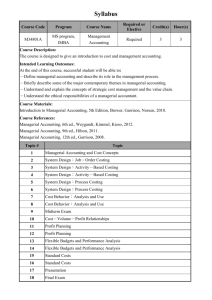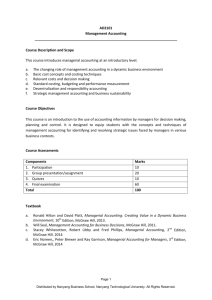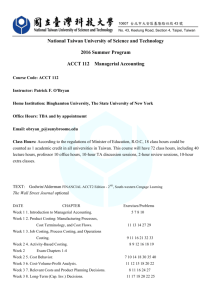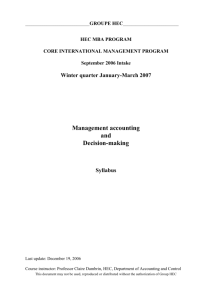It costs me more: decision making, cost accounting and value creation
advertisement
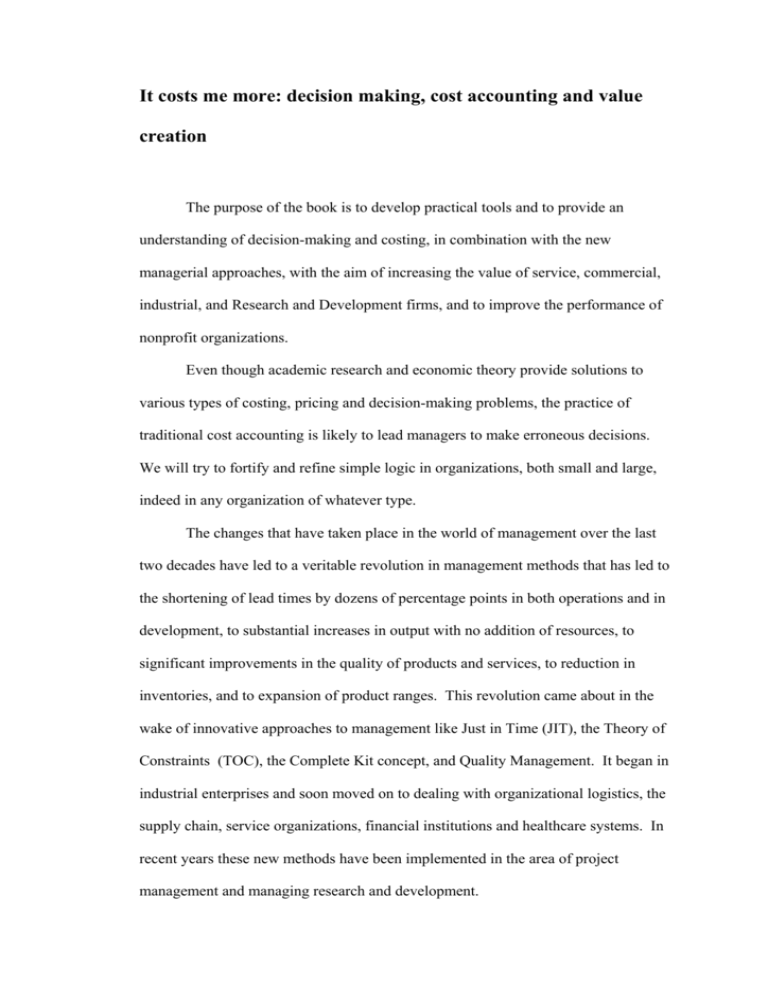
It costs me more: decision making, cost accounting and value creation The purpose of the book is to develop practical tools and to provide an understanding of decision-making and costing, in combination with the new managerial approaches, with the aim of increasing the value of service, commercial, industrial, and Research and Development firms, and to improve the performance of nonprofit organizations. Even though academic research and economic theory provide solutions to various types of costing, pricing and decision-making problems, the practice of traditional cost accounting is likely to lead managers to make erroneous decisions. We will try to fortify and refine simple logic in organizations, both small and large, indeed in any organization of whatever type. The changes that have taken place in the world of management over the last two decades have led to a veritable revolution in management methods that has led to the shortening of lead times by dozens of percentage points in both operations and in development, to substantial increases in output with no addition of resources, to significant improvements in the quality of products and services, to reduction in inventories, and to expansion of product ranges. This revolution came about in the wake of innovative approaches to management like Just in Time (JIT), the Theory of Constraints (TOC), the Complete Kit concept, and Quality Management. It began in industrial enterprises and soon moved on to dealing with organizational logistics, the supply chain, service organizations, financial institutions and healthcare systems. In recent years these new methods have been implemented in the area of project management and managing research and development. 2 The revolution in management methods is taking place today concurrently with the rapid technological advances in the field of communication, the Internet, and information technology. The technological innovation has meant that time to market (TTM) has become an issue of prime importance, to which the management methods that have been developed have made a major contribution. The traditional managerial accounting tools, and particularly the cost accounting practices, have not been adapted to the new perceptions. In some cases organizations stopped the implementation of the new approaches. Only too often are wrong decisions made leading to sub-optimal results when applying traditional accounting to problems such as make or buy, accept or reject a project, submit an offer to tender, determining production lot sizes or work package size in development, expansion or discontinuation of a product line or service. This book presents support tools for costing and decision-making in the modern business environment. Three important changes have taken place in the business environment: 1. Today, the direct labor component is in most cases a fixed cost (in the short term and in the long term). 2. The indirect costs component, which was 5% of the operating costs in the 1920s, when traditional cost accounting was constructed, has become a substantial element (30%-80%). 3. The new management methods distinguish clearly between surplus resources (non-critical resources) and scarce resources (bottlenecks, constraints). Traditional cost accounting deals mainly with the inventory system (work in process and finished goods inventory) in industry. A need has been felt in recent years to develop managerial accounting for other measurement and control issues 3 that are also relevant to service organizations, which do not manufacture physical products. These changes do not conform with the premises on which traditional absorption costing is based and they lead the user to erroneous decisions. Recent years have seen an increase in the use of target costing and its integration today with the Theory of Constraints provides good tools for coping with decision-making problems, particularly for senior management. The book presents innovative methodologies, some of which have been developed by the authors and implemented in dozens of, which can be used to achieve better decision-making. These tools, such as the three-stage decision-making methodology and the Value Focused Management (VFM) model for increasing shareholders’ value, help managers in all types of organizations to cope with problems for which the methodologies of traditional cost accounting or the ABC approach have no suitable answer. This book focuses on providing decision support tools and coping, inter alia, with the following problems: • Price setting • Selecting the product or service mix • Make or buy decision making • Deciding on whether to halt a product or service line • Determining transfer prices • Determining a price for a tender • Investments Justification • Assessing the value derived from reducing project time to market. 4 We determined the need to write a book like this from our experience in teaching courses focusing on value creation, managerial accounting, operations management (particularly for graduate students), from dozens of executive training workshops, from consulting and implementation in leading firms, from membership in boards of directors, and from the many discussions we have had with managers. This book focuses on the costing and pricing aspects of the new approaches to management and on the making of managerial decisions and their practical implementation, presenting the reader with a consistent and critical perspective based on common sense and business logic. Our approach is based on the perception that the goal of the firm is to better its value for the shareholders, and that it can do this with the help of the VFM model, the three-stage methodology, and the other tools, philosophies and techniques based on the following perceptions. 5 1. Global vision Costing is essentially a control tool and a decision support tool. In any case, decisionmaking has to be examined in a global system perspective, and the effects of the decisions on the organization as a whole, particularly on the overall value of the organization, have to be considered. 2. Focusing Data need to be collected systematically and comprehensively, focusing on the essentials. Control and management too are focused. 3. 4. Traditional cost accounting Traditional cost accounting can serve for as a control and reference control and reference only, not as a decision- tool making tool. Integrating innovative Costing, pricing and decision-making are in approaches to management the spirit of the new approaches to management. 5. Decision making Decision-making is carried out taking account of the organization’s resources and constraints. The book is intended for managers in all areas of industry, service organizations, financial institutions and nonprofit organizations. Students of business administration will also find it very useful. It does not purport to discuss all the issues that managerial accounting addresses, but rather focuses on questions that in our opinion contribute more to the betterment of firm value, while presenting the global perspective. 6 About the Authors Professor Yoram Eden, CPA, is Dean of the School of Business Administration, the College of Management, Tel Aviv. He is a member of the Accountants Council and the Central Committee of the Association of Accountants in Israel, Editor of the Hebrew language journal “The Accountant”, and a member of the Education Committee of the International Federation of Accountants (IFAC). In addition to his academic and public activities, Professor Eden has much practical experience as an accountant and consultant to firms and organizations in the areas of costing and managerial accounting. Professor Boaz Ronen is a professor at the Faculty of Management, Tel Aviv University. He specializes in technology management and methodologies to increase shareholders’ value. He has implemented value creation projects and introduced innovative management approaches in dozens of firms and organizations in Israel and abroad. Professor Ronen has been a visiting professor at the business schools of Columbia University, NYU, Bocconi, and others, and has published scores of papers in leading academic and professional journals. He also worked for 10 years in Israel’s hi-tech industry, prior to embarking on his academic career.
